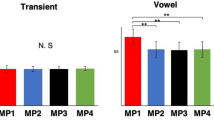Abstract
Music and speech are very cognitively demanding auditory phenomena generally attributed to cortical rather than subcortical circuitry. We examined brainstem encoding of linguistic pitch and found that musicians show more robust and faithful encoding compared with nonmusicians. These results not only implicate a common subcortical manifestation for two presumed cortical functions, but also a possible reciprocity of corticofugal speech and music tuning, providing neurophysiological explanations for musicians' higher language-learning ability.



Similar content being viewed by others
References
Rauschecker, J.P. Curr. Opin. Neurobiol. 8, 516–521 (1998).
Patel, A.D. Nat. Neurosci. 6, 674–681 (2003).
Wong, P.C., Parsons, L.M., Martinez, M. & Diehl, R.L. J. Neurosci. 24, 9153–9160 (2004).
Wong, P.C.M., Perrachione, T.K. & Parrish, T.B. Hum. Brain Mapp. (in the press).
Russo, N.M., Nicol, T.G., Zecker, S.G., Hayes, E.A. & Kraus, N. Behav. Brain Res. 156, 95–103 (2005).
Greenberg, S., Marsh, J.T., Brown, W.S. & Smith, J.C. Hear. Res. 25, 91–114 (1987).
Krishnan, A., Xu, Y., Gandour, J. & Cariani, P. Cogn. Brain Res. 25, 161–168 (2005).
Li, W., Piech, V. & Gilbert, C.D. Nat. Neurosci. 7, 651–657 (2004).
Slevc, L.R. & Miyake, A. Psychol. Sci. 17, 675–681 (2006).
Suga, N., Gao, E., Zhang, Y., Ma, X. & Olsen, J.F. Proc. Natl. Acad. Sci. USA 97, 11807–11814 (2000).
Schon, D., Magne, C. & Besson, M. Psychophysiology 41, 341–349 (2004).
Nosofsky, R.M. J. Exp. Psychol. Gen. 115, 39–61 (1986).
Ahissar, M. & Hochstein, S. Trends Cogn. Sci. 8, 457–464 (2004).
Johnson, K.L., Nicol, T.G. & Kraus, N. Ear Hear. 26, 424–434 (2005).
Gordon, M. & O'Neill, W.E. J. Comp. Neurol. 426, 165–181 (2000).
Acknowledgements
The authors thank J. Song, B. Williams, J. Alexander, A. Bradlow, T. Nicol, and T. Perrachione for their assistance in this research. This work is supported by Northwestern University and the US National Institutes of Health grant R03HD051827 and R21DC007468 to P.W. and R01DC001510 to N.K, and National Science Foundation grant BCS-0544846 to N.K.
Author information
Authors and Affiliations
Corresponding author
Ethics declarations
Competing interests
The authors declare no competing financial interests.
Supplementary information
Supplementary Fig. 1
f0 contours of the three stimuli. (PDF 30 kb)
Supplementary Table 1
Subjects' musical history. (PDF 8 kb)
Rights and permissions
About this article
Cite this article
Wong, P., Skoe, E., Russo, N. et al. Musical experience shapes human brainstem encoding of linguistic pitch patterns. Nat Neurosci 10, 420–422 (2007). https://doi.org/10.1038/nn1872
Received:
Accepted:
Published:
Issue Date:
DOI: https://doi.org/10.1038/nn1872
- Springer Nature America, Inc.
This article is cited by
-
Exploring the role of singing, semantics, and amusia screening in speech-in-noise perception in musicians and non-musicians
Cognitive Processing (2024)
-
Individual variability in subcortical neural encoding shapes phonetic cue weighting
Scientific Reports (2023)
-
A large-scale repository of spoken narratives in French, German and Spanish from Cantonese-speaking learners
Scientific Data (2023)
-
Enduring musician advantage among former musicians in prosodic pitch perception
Scientific Reports (2023)
-
Neural Processing of Speech Sounds in ASD and First-Degree Relatives
Journal of Autism and Developmental Disorders (2023)





